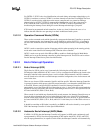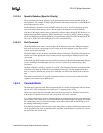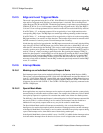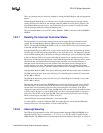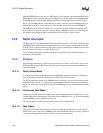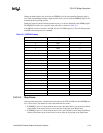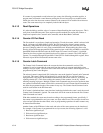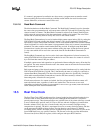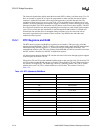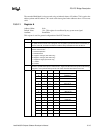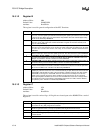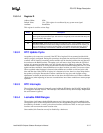
Intel® 460GX Chipset Software Developer’s Manual 15-11
PCI/LPC Bridge Description
The Counter Latch Command latches the current count so that it can be read by the system. The
countdown process continues.
The Read Back Command reads the count value, programmed mode, the current state of the OUT
pins, and the state of the Null Count Flag of the selected counter.
The Read/Write Logic selects the Control Word Register during an I/O write when address lines
A[1:0]=11. This condition occurs during an I/O write to port address 043h, the address for the
Control Word Register on Timer 1. If the CPU writes to port 043h, the data is stored in the Control
Word Register and is interpreted as the Control Word used to define the operation of the Counters.
The Control Word Register is write-only. Counter status information is available with the read back
Command.
Because the timer counters wake up in an unknown state after power up, multiple refresh requests
may be queued. To avoid possible multiple refresh cycles after power up, program the timer
counter immediately after power up.
15.4.1.1 Write Operations
Programming the interval timer is a simple process:
1. Write a control word.
2. Write an initial count for each counter.
3. Load the least and/or most significant bytes (as required by Control Word bits 5, 4) of the 16-
bit counter.
The programming procedure for the IFB timer is very flexible. Only two conventions need to be
observed. First, for each counter, the control word must be written before the initial count is
written. Second, the initial count must follow the count format specified in the control word (least
significant byte only, most significant byte only, or least significant byte and then most significant
byte).
Since the Control Word Register and the three counters have separate addresses (selected by the
A1, A0 inputs), and each control word specifies the counter it applies to (SC0, SC1 bits), no special
instruction sequence is required. Any programming sequence that follows the conventions above is
acceptable.
A new initial count may be written to a counter at any time without affecting the counter’s
programmed mode. Counting will be affected as described in the mode definitions. The new count
must follow the programmed count format.
If a counter is programmed to read/write two-byte counts, the following precaution applies: A
program must not transfer control between writing the first and second byte to another routine
which also writes into that same counter. Otherwise, the counter will be loaded with an incorrect
count.
15.4.1.2 Interval Timer Control Word Format
The control word specifies the counter, the operating mode, the order and size of the count value,
and whether it counts down in a 16-bit or binary-coded decimal (BCD) format. After writing the
control word, a new count may be written at any time. The new value will take effect according to
the programmed mode.



